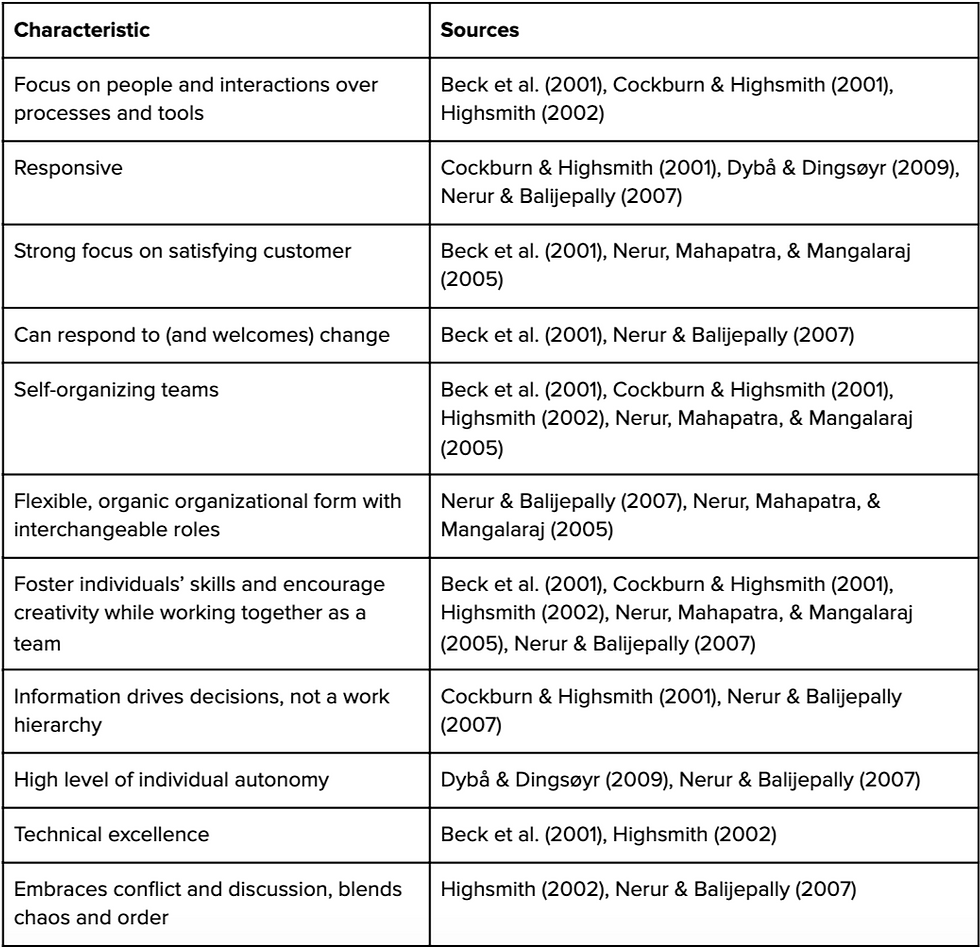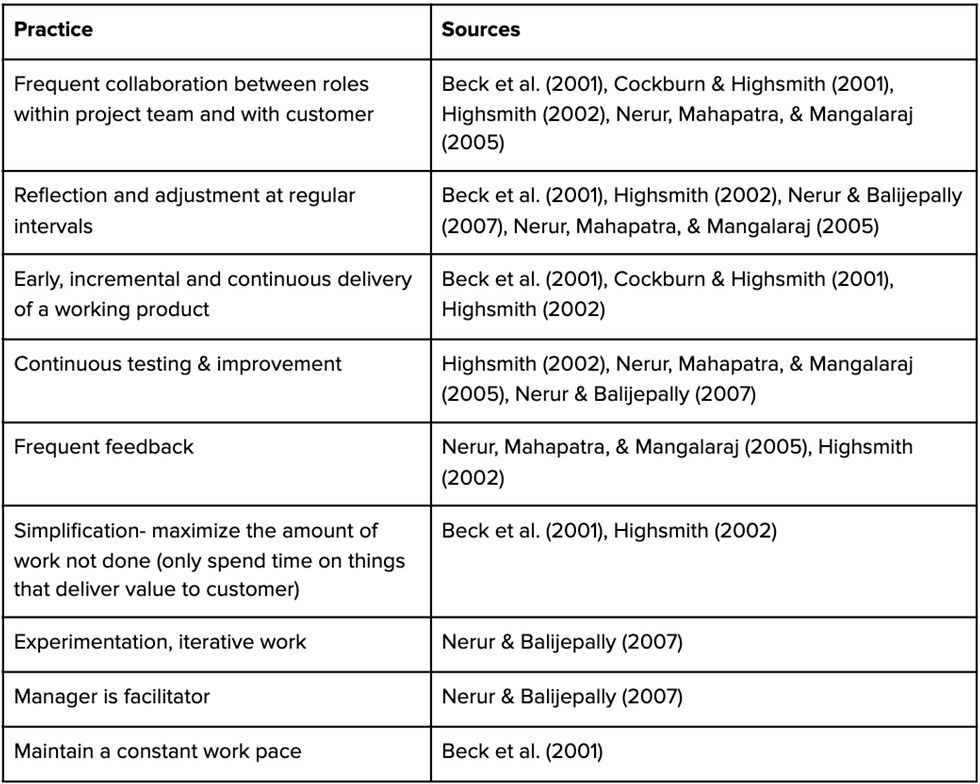Encouraging rather than "implementing" agile
- Trey Hahn
- Feb 4, 2020
- 5 min read
Updated: Sep 20, 2023
A prior lesson stated that agile must be implemented in an agile way. In this mini lesson, I go deeper into this subject. Should we be trying to implement agile at all? Or, should we be encouraging an agile way of working? What is the difference? I will explain. Note: are you not familiar with an "agile" way of working? Read this post first.
I first give background on existing professional experiences with implementation¹ of an agile way of working through prescribed methodologies ("frameworks"). Later in the lesson, we move to consider feasibility and desirability of alternative structures of agile working, including "encouraging" an agile way of working...
While the ideas behind agile do resonate with people, its implementations (e.g. Scrum, Kanban)- what have become especially well-known in industry- resonate much less. It could be the case that professionals have high exposure to these implementations- higher than to the ideas behind agile. And that through bad experiences with the implementations, they develop negative perceptions to the term "agile" in general.
In professionals' anecdotal reports, it is not uncommon to hear mentions of negative experiences with practices that are not in line with the ideas that comprise agile. It could be the case that these implementations of an agile way of working are "more regulated frameworks, with followers who enforce their version of ‘Agile’ as the only right approach"(Morris, 2015, abstract). Ironically, because focus on "enforcing" a set of rules for working does not lend itself to being agile.
On the contrary, agile is a vision for a way of working. The Manifesto for Agile Software Development (Beck et al., 2021) - a major reference piece for agile working in the technology fields- places more value in "Individuals and interactions" than in "processes and tools". Frameworks for implementation are supporting structures which by nature may comprise processes and tools. Thus, there is an inherent conflict between an implementation framework and the thought of agile.

What is "agile" when it is happening? Characteristics of agile organizations. Table by author (for full references see here).
Organic agile?
With this background in mind, I proceed in an entirely different direction. As an illustrative exercise, what would agile working look like without frameworks for implementation?...
If agile working were to occur without structure from the top, one could assume this working would arise naturally, from the working team itself.
In terms of desirability, this seems like a good path. However, what is there to suggest that this "organic agile" could happen outside of circumstances of complete chance? Or outside of intentionally building a team that is all aligned to work in this way?
Perhaps it could happen in rare cases. For example in a case where people happen to be on the same page, like all of the authors of the Manifesto for Agile Software Development. Or, perhaps it could happen in small sub-groups of a larger team.
I add as commentary that team chemistry is hard to plan. Sometimes, a "click" just happens. This does not make it easier to predict under which specific circumstances "organic agile" could occur.
In short, while this scenario is not impossible, it seems not widely feasible given its lack of predictable reproducibility.

Practices of agile organizations. Table by author.
Implementing vs Encouraging
From the illustrative example it is clear that organic agile is often not feasible. Upon examination of the practices of agile organizations, holes also appear in the feasibility of the implementing scenario (see thought exercise in footnote²). This would make sense given the negative experiences that some professionals report with them.
We now move to a third scenario: instead of organic agile or agile that is fully implemented from the top, is there a middle ground? It is here where we consider: can you "encourage" agile working, in a way where favorable conditions make it more likely to occur naturally?
In other words, is there a "carrot" instead of a "stick" that motivates people to work in an agile way? In a voluntary way, where people act (to some extent) on their own initiative?
This scenario would require certainty on the variables that need to be considered in order to encourage this way of working. I do not what these are, or the optimal arrangement of them. Upon initial assessment I would presume that there are both general people-oriented variables and specific variables based on practical working conditions per field.
Given certainty on these variables, organizations would have confidence in what they would need to invest in. In this case, desirability for this scenario is high. Costs may be relatively low compared to the implementing scenario, with less potential for disturbance to employees.
Feasibility for this scenario would be entirely dependent on the study and subsequent certainty of what "carrot"s are needed in the work environment. Thus, without that knowledge it is unfeasible. With that knowledge, it would be feasible.
Where do we turn for it? This knowledge is not traditionally the focus of urban mobility training. Thus, we'd need to turn to other fields.
Discussion
With as background the negative experiences people have with the implementation of agile, this mini lesson presented two alternatives.
As a remedy to implementation methodologies that in ways ironically force agile working through specific processes, we considered the desirability and feasibility of "organic agile" and "encouraging agile".
As closing thoughts: agile is a vision for a way of working. Implementation frameworks lend to the idea that this way of working can be mechanically reproduced. While I cannot speak to the effectiveness of each individual framework, I suggest that the idea this suggests is problematic. And when methodologies are proprietary, this lends to the idea that an agile way of working is a product that can be purchased. I suggest caution with this.
As a play-on-words: there is sometimes an implicit framing that your organization can benefit from agile if you do it. However, agile is a vision. You don't do this vision, it happens.
Reflection exercise: What agile characteristics and practices (reference the tables above) do you see present in your work as an urban mobility professional working on cycling projects?
Want to learn more about agile bicycle planning? Enroll in our online course, and check out our other instructional offerings.
¹Implementation meaning specific prescriptions of practices or "frameworks" that are intended to facilitate an agile way of working, such as Scrum. Thus how agile values are implemented in a practical workflow.
²Referring to the table "Practices of agile organizations", we start with the first practice of collaboration. Questions arise when considering if this practice is implementable. Can you implement collaboration? Does it require individual initiative by each party to decide to do this and engage with each other? Further, should you try to implement this - how does the nature of the collaboration change when you force it from the top?
For the second practice of reflection, we run into similar questions. It is a desirable practice when it occurs, but by nature it is more of an organic phenomenon that cannot be reproduced on call in its natural form.


Comments